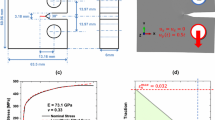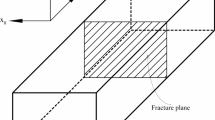Abstract
Ductile materials are found to sustain brittle fracture when the crack moves at high speed. This fact poses a paradox under current theories of dislocation emission, because even at high velocities, these theories predict ductile behavior. A theoretical treatment of time-dependent emission and cleavage is given which predicts a critical velocity above which cleavage can occur without emission. Estimates suggest that this velocity is in the neighborhood of the sound velocity. The paper also discusses the cleavage condition under mixed mode loading, and concludes that the cleavage condition involves solely the mode I loading, with possible sonic emission under such loadings
Similar content being viewed by others
References
A. Kelly, W. Tyson, and A. H. Cottrell, Philos. Mag. 29, 295 (1967).
J. Rice and R. Thomson, Philos. Mag. 29, 73 (1974).
S. J. Chang and S. M. Ohr, J. Appl.Phys. 52, 7174 (1981).
J. Weertman, Philos. Mag. 43, 1103 (1981).
I.-H. Lin and R. Thomson, Acta Metall. 34, 187 (1986).
S. M. Ohr, Mater. Sci. Eng. (to be published).
H. G. F. Wilsdorf, Mater. Sci. Eng. 59. 1 (1983).
H. Vehoff and P. Neumann, Acta Metall. 28, 265 (1980).
B. Hockey, Fracture Mechanics in Ceramics, edited by R. Bradt, D. Hasselman, and F. Lange (Plenum, New York, 1983), Vol. 6, p. 637.
E. N. Pugh, in Atomistics of Fracture, edited by R. M. Latanision and J. R. Pickins (Plenum, New York, 1983), p. 209.
K. Sieradsky, R. L. Sabatini, and R. C. Newman, Met. Trans. 15A, 1941 (1984).
E. Smith, Proceedings of the Conference on Physical Basis of Yield and Fracture (Institute of Physics and the Physical Society, London, 1966), p. 36.
J. Hirth and J. Lothe, Theory of Dislocations (McGraw-Hill, New York, 1982).
J. Eshelby, Physics of Strength and Plasticity, E. Orowan Anniversary Volume, edited by A. Argon (MIT Press, Cambridge, 1969), p. 263.
L. B. Freund, Mech. Phys. Sol. 20, 129 (1972).
J. Eshelby, Solid State Phys. 3, 79 (1956).
C. Atkinson and J. Eshelby, Int. J. Fracture 4, 3 (1968).
G. C. Sih, Int. J. Fracture 4, 51 (1967).
J. R. Radok, Quart. J. Appl. Math. 14, 289 (1956).
X. Markenskoff, Dislocation Modeling of Physical Systems, edited by M. Ashby, R. Bullough, C. Hartley, and J. Hirth (Pergamon, New York, 1981), p. 244.
L. B. Freund, Int. J. Eng. Sci. 12, 179 (1974).
Author information
Authors and Affiliations
Rights and permissions
About this article
Cite this article
Lin, IH., Thomson, R.M. Dynamic cleavage in ductile materials. Journal of Materials Research 1, 73–80 (1986). https://doi.org/10.1557/JMR.1986.0073
Received:
Accepted:
Published:
Issue Date:
DOI: https://doi.org/10.1557/JMR.1986.0073




